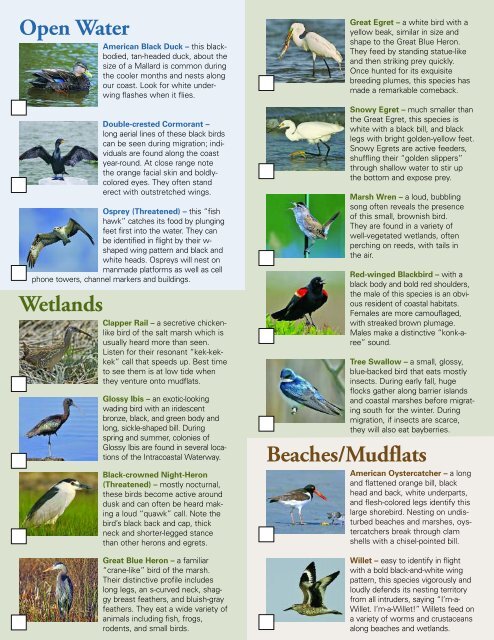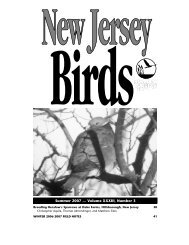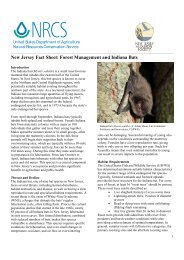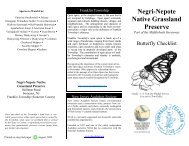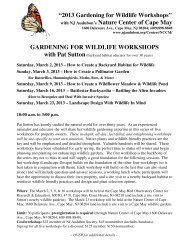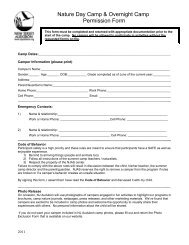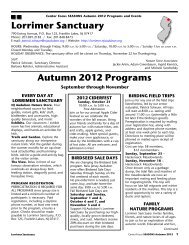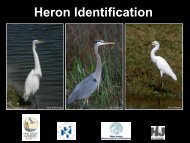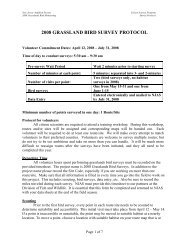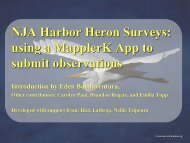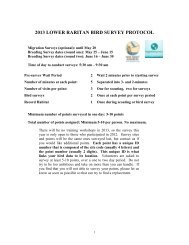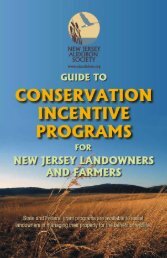Birding for Boaters - New Jersey Audubon Society
Birding for Boaters - New Jersey Audubon Society
Birding for Boaters - New Jersey Audubon Society
Create successful ePaper yourself
Turn your PDF publications into a flip-book with our unique Google optimized e-Paper software.
Open WaterAmerican Black Duck – this blackbodied,tan-headed duck, about thesize of a Mallard is common duringthe cooler months and nests alongour coast. Look <strong>for</strong> white underwingflashes when it flies.Double-crested Cormorant –long aerial lines of these black birdscan be seen during migration; individualsare found along the coastyear-round. At close range notethe orange facial skin and boldlycoloredeyes. They often standerect with outstretched wings.Osprey (Threatened) – this “fishhawk” catches its food by plungingfeet first into the water. They canbe identified in flight by their w-shaped wing pattern and black andwhite heads. Ospreys will nest onmanmade plat<strong>for</strong>ms as well as cellphone towers, channel markers and buildings.WetlandsClapper Rail – a secretive chickenlikebird of the salt marsh which isusually heard more than seen.Listen <strong>for</strong> their resonant “kek-kekkek”call that speeds up. Best timeto see them is at low tide whenthey venture onto mudflats.Glossy Ibis – an exotic-lookingwading bird with an iridescentbronze, black, and green body andlong, sickle-shaped bill. Duringspring and summer, colonies ofGlossy Ibis are found in several locationsof the Intracoastal Waterway.Black-crowned Night-Heron(Threatened) – mostly nocturnal,these birds become active arounddusk and can often be heard makinga loud “quawk” call. Note thebird’s black back and cap, thickneck and shorter-legged stancethan other herons and egrets.Great Blue Heron – a familiar“crane-like” bird of the marsh.Their distinctive profile includeslong legs, an s-curved neck, shaggybreast feathers, and bluish-grayfeathers. They eat a wide variety ofanimals including fish, frogs,rodents, and small birds.Great Egret – a white bird with ayellow beak, similar in size andshape to the Great Blue Heron.They feed by standing statue-likeand then striking prey quickly.Once hunted <strong>for</strong> its exquisitebreeding plumes, this species hasmade a remarkable comeback.Snowy Egret – much smaller thanthe Great Egret, this species iswhite with a black bill, and blacklegs with bright golden-yellow feet.Snowy Egrets are active feeders,shuffling their “golden slippers”through shallow water to stir upthe bottom and expose prey.Marsh Wren – a loud, bubblingsong often reveals the presenceof this small, brownish bird.They are found in a variety ofwell-vegetated wetlands, oftenperching on reeds, with tails inthe air.Red-winged Blackbird – with ablack body and bold red shoulders,the male of this species is an obviousresident of coastal habitats.Females are more camouflaged,with streaked brown plumage.Males make a distinctive “konk-aree”sound.Tree Swallow – a small, glossy,blue-backed bird that eats mostlyinsects. During early fall, hugeflocks gather along barrier islandsand coastal marshes be<strong>for</strong>e migratingsouth <strong>for</strong> the winter. Duringmigration, if insects are scarce,they will also eat bayberries.Beaches/MudflatsAmerican Oystercatcher – a longand flattened orange bill, blackhead and back, white underparts,and flesh-colored legs identify thislarge shorebird. Nesting on undisturbedbeaches and marshes, oystercatchersbreak through clamshells with a chisel-pointed bill.Willet – easy to identify in flightwith a bold black-and-white wingpattern, this species vigorously andloudly defends its nesting territoryfrom all intruders, saying “I’m-a-Willet. I’m-a-Willet!” Willets feed ona variety of worms and crustaceansalong beaches and wetlands.


